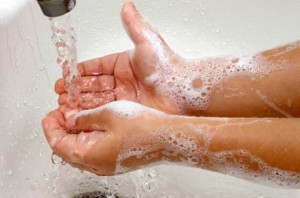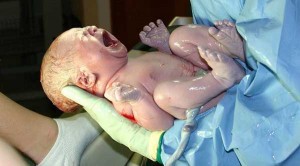Vaginal deliveries can sometimes result in trauma to the perineum. Immediately after childbirth, while your baby is examined, your doctor will check for signs of injury. Stretching of the skin and vagina can cause natural tears, or you may have needed an episiotomy.
Natural tears of the perineum can occur as the baby passes through the vagina. These perineal injuries are classified as:
➪ First Degree: a slight nick of the vaginal opening which may or may not need to be repaired
➪ Second Degree: tears of the vagina mucosa or underlying connective tissues
➪ Third Degree: a tear that extends to the muscle around the anus
➪ Fourth Degree: a vaginal wall tear that extends into the rectum
To prevent such injuries, many obstetricians opt to do an episiotomy. This procedure can minimize the amount of perineal trauma, and provides clean borders for an easier repair.
Both an episiotomy and natural tears are repaired with surgical sutures while you are still on the delivery table. If no epidural anesthesia was used throughout the labor and delivery, a local anesthetic will be injected into the area before your wound is repaired. Depending on the size of the tear or episiotomy, the repair usually takes about 10 to 20 minutes.
Your doctor will use absorbable sutures which will hold the tissues and skin together for four to six weeks; they do not need to be removed. By that time, the area should be strong, and the edges should not separate. If you notice stitches on your sanitary pad, check your episiotomy with a mirror to make sure the skin is still closed and is healing.
While your perineum is healing, it is best to take showers. Full tub baths are typically not recommended during the first four weeks postpartum. However, Sitz baths may reduce pain. You may clean the incision with mild, unscented soap. It is normal to have mild discomfort during the first two weeks of healing. However, if the episiotomy or repaired tear becomes increasingly painful, call your doctor. Pain medication may be prescribed in addition taking over-the-counter acetaminophen or ibuprofen. You should avoid taking aspirin, however, which can cause bleeding. If post-birth vaginal bleeding seems heavier after using stairs, limit stair climbing as much as possible.
If there are no complications, the perineum should be completely healed in about six weeks. To prevent constipation or straining while passing stools, it is important to drink plenty of fluids and eat a high-fiber diet.
Proper perineal care is important to prevent infections of the healing wound, bladder, and uterus. The perineum should be kept clean, and free of dried blood. Changing sanitary pads at least every four hours will also help prevent infections. Pads should be changed each time you use the bathroom and after bathing. Because of the risk of trauma or infection, tampons are not recommended. Do not use them until your doctor says it is OK. The perineal care regimen should be continued until there is no more post-delivery vaginal discharge (lochia).
Steps for Proper Perineal Care
1. Wash your hands. Do so before and after perineal care.
2. Sanitary Pad Removal: If your sanitary pad has adhered to your skin, gently “peel” it off in a front to back motion. This avoids bringing bacteria from the anus to the vaginal or urinary areas. Discard soiled pads in a lined trash can or plastic bag, not in the toilet. Avoid touching the soiled portions of the pad.
3. Peri-bottle Use: After urinating but while still sitting on the toilet, pour warm tap water over the outside of the perineum, beginning near the urethra, then moving back toward the anal area. Do not squirt water directly into the vagina. Afterward, pat dry with toilet paper. White, unscented toilet paper is best to prevent irritation. Follow this by gently wiping the perineum with witch hazel. Use a clean piece of toilet paper or witch hazel pad, and drop used ones into the toilet after each wipe. It is important to always clean and wipe from front to back to prevent a urinary tract or wound infection. Always wash the peri-bottle and your hands thoroughly.
4. Local Pain Relief: Apply a spray or ointment if your doctor has ordered it. These medications promote healing and provide comfort.
5. Infection Prevention: Do not flush the toilet until after you stand up. Bacteria in the toilet bowl may splash onto the perineum if you remain seated. While opening and putting on a clean sanitary pad, avoid touching the area that will be in contact with your skin and sutures.
6. Voiding and Stooling Difficulties: Urine can irritate the skin of the perineum, and cause a stinging sensation on the episiotomy or tears. To prevent contact, void while standing astride the toilet so the urine flows straight down. Alternatively, urinate while taking a shower. You may feel the urge to urinate quite frequently during the first five days postpartum. The body is getting rid of fluid it no longer needs. Because of this, anesthesia effects, and uterine pressure, normal bladder function may not resume until four to seven days later. If it is difficult for you to urinate, try pouring warm water over the perineum while sitting on the toilet, or listen to water running in the sink. If you are unable to urinate or have signs of a urinary tract infection, call your doctor.
After a bowel movement, gently clean the anal area with toilet paper. Witch hazel pads can then be used to reduce minor itching or burning from the sutures or hemorrhoids. Use a clean piece of toilet paper or witch hazel pad with each wipe, and never wipe toward the front of the perineum. Discard used toilet paper and pads into the toilet.
Proper Hand Washing to Prevent Infection
 Always wash your hands thoroughly before and after using the bathroom or changing a sanitary pad. Proper handwashing is the best way to prevent infections in your and your baby. The following are steps for proper handwashing.
Always wash your hands thoroughly before and after using the bathroom or changing a sanitary pad. Proper handwashing is the best way to prevent infections in your and your baby. The following are steps for proper handwashing.
1. Wash your hands for at least 20 seconds in warm water and with soap. Keep your fingertips pointed toward the bottom of the sink, and your hands lower than your elbows. This allows the soap, water, and germs to run down the drain, not down your arms.
2. Pay special attention to fingernails, between your fingers, and areas that look dirty.
3. Don’t touch anything while washing your hands.
4. Rinse your hands and wrists well, then dry them with a clean towel.
5. Use the towel to turn off the faucet, and avoid touching it with your clean hands.
Ways to Speed Healing and Relieve Discomfort
These tips may help you heal, and reduce discomfort:
✔ Expose the perineum to air while you are resting or napping. Be sure to protect your furniture and bedding by placing a thick towel or plastic-lined pad underneath you.
✔ Avoid standing or sitting positions that increase pressure on the perineum; this includes not standing or sitting for long periods of time
✔ Pour warm water over your perineum while urinating
✔ Lie on your side while resting or napping
✔ Sit on a pillow or rubber “donut” ring
✔ Take 10 to 20 minute Sitz baths
✔ Apply a witch hazel pad between your stitches and the sanitary pad for about 15 minutes
✔ Use ice packs wrapped in a towel to relieve pain. Ice should not be applied directly to the skin.
✔ Avoid straining with bowel movements. Hold a pad of toilet paper against the sutures to reduce pressure on them while passing stools. Your doctor may also recommend a stool softener until the area has healed.
Sitz Bath You may be allowed to take home your hospital Sitz bath pan. Your doctor will provide instructions on how frequently and how long to take Sitz baths. Typically 10 to 20 minutes is recommended. Sitz baths can shorten healing time, and relieve discomfort. It is important to check the water temperature with your wrist before sitting in the bath. The perineum may be less sensitive to heat or cold while it is healing, or when using an anesthetic spray or ointment to relieve discomfort. Alternatively, you can use your bathtub for the Sitz bath. First, wash your feet and legs, then fill the bathtub with three inches of warm water. While sitting in the tub, the water should just cover your perineum.
Strengthening the Perineal Muscles
During pregnancy, the pelvic muscles carry the increasing weight of the uterus and your baby. The perineal muscles are also stretched during childbirth. This extra weight and stretching can cause these muscles to lose some of their strength and tone. Although this will gradually improve, Kegel exercises can help.
Strengthening the pelvic and perineal muscles helps reduce problems such as urinary leaks and vaginal or rectal prolapse. It is not uncommon for small amounts of urine to leak from your bladder until these muscles return to their pre-pregnancy state. Urinary accidents, known as incontinence, can occur while coughing, sneezing, straining, laughing, or picking up your baby. This may also have occurred during the third trimester of your pregnancy due to pressure of the uterus on your bladder. Kegel exercises will help you to regain bladder control, and have less perineal discomfort. They may have been encouraged during your pregnancy and should be continued after you are discharged from the hospital.
In addition to urinary incontinence, pressure during birth can cause a temporary loss of sensation on the perineum. Because of irritated nerves, the perineal area may feel numb. It may be difficult to feel the muscle contractions while doing Kegel exercises. However, normal sensation should gradually return within a few weeks.
How to Do Kegel Exercises:
- Identify which perineal muscles allow you to start and stop urinating.
- Squeeze the perineal muscles as if attempting to stop the flow of urine.
- Hold this contraction for five to 10 seconds, then relax the muscles.
For optimal results, do a cycle of 10 contractions, several times a day. Your doctor can determine how frequently should do Kegel exercises depending on your specific needs. No one can tell when you are doing Kegels, and they can be done anywhere. Do a few during the commercials while you watch TV.
More About Self-Care After Vaginal Birth
Introduction to Self-care After Vaginal Birth
Preventive Self Care
Perineal Care
Physical Changes and Healing
Breast Care
Activities and Healthy Exercise
Nutrition and Diet
Family Planning and Birth Control
Normal “Baby Blues” or Postpartum Depression
Your Postpartum Check-Up
Get as Much Rest as You Can
When to Call Your Doctor

FYI
Involution is a normal process where the uterus continues to contract until it shrinks to its non-pregnant size of a pear.
TIP 2
When you are ready to change sanitary pads, have a clean sanitary pad, witch hazel pads, and the peri-bottle (squeeze bottle) nearby. Rinse out the peri-bottle and fill it with warm, not hot, tap water. Then follow steps 1 through 5 under Proper Perineal Care.
You can make witch hazel pads with soft 2” x 2” non-sterile gauze pads and witch hazel. Always pour the witch hazel to a clean gauze pad so as not to introduce germs into the bottle. You can also buy pre-soaked witch hazel pads at your drug store.
For cold witch hazel pads, keep the bottle of witch hazel or some pre-soaked witch hazel pads in the refrigerator.
TIP 3
It’s normal to fear that your repair may re-open with sudden movements. Coughing, sneezing, straining, and laughing put a lot of pressure on the healing wound and sutures. Try tightening the perineal muscles before you cough, sneeze, strain, or laugh, and then relax them afterward.
You can relieve discomfort by pressing your sanitary pad against the area for support before coughing or sneezing.
